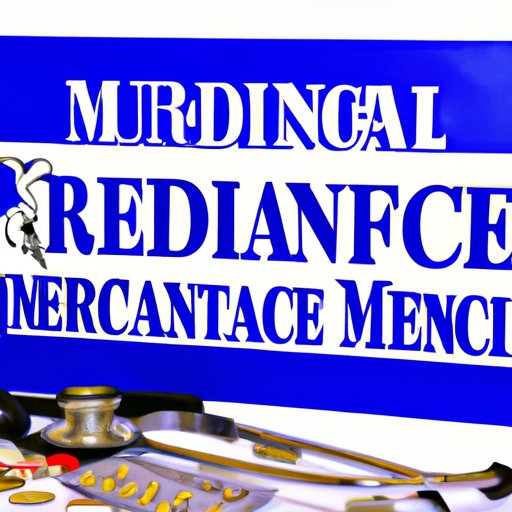Introduction
Medicare is a federal health insurance program that provides coverage for people 65 and older, and certain younger people with disabilities. It’s one of the most important safety nets for seniors in the United States, offering access to essential healthcare services and helping to reduce financial burdens. But what does Medicare pay for? That’s an important question, and one that can be difficult to answer. In this article, we’ll explore the various parts of Medicare and what they cover, as well as how much Medicare pays for each part.
Exploring the Benefits of Medicare: A Guide to What Medicare Pays
Medicare is made up of four parts: A, B, C, and D. Each of these parts covers different types of care and services, and each has its own cost structure. Let’s take a look at each part in turn.
Medicare Parts A and B
Medicare Part A covers hospital stays, skilled nursing care, hospice care, and some home health care. It also covers certain preventive services, like flu shots and screenings for cancer and other diseases. Part A is free for most people, but there may be some out-of-pocket costs depending on your situation.
Medicare Part B covers doctor visits, durable medical equipment, outpatient care, and some home health care. It also covers certain preventive services, like flu shots and screenings for cancer and other diseases. Part B requires a monthly premium, and there may be some out-of-pocket costs depending on your situation.
Medicare Part C
Medicare Part C, also known as Medicare Advantage, is a type of private health insurance plan offered by insurance companies. It covers all of the same services as Parts A and B, plus additional services like vision and dental care. Part C plans typically have lower premiums than traditional Medicare, but they may also have higher out-of-pocket costs.
Medicare Part D
Medicare Part D is a prescription drug coverage plan offered by private insurance companies. It covers drugs prescribed by your doctor or other healthcare provider. Part D plans have varying premiums and out-of-pocket costs, so it’s important to compare plans before enrolling.
Understanding Your Medicare Coverage: What Does Medicare Pay for?
Now that you know the basics of what Medicare covers, let’s take a look at what Medicare pays for. When it comes to Medicare coverage, there are two main categories of payments: deductibles and premiums, and copayments and coinsurance.
Deductibles and Premiums
Deductibles are the amount you must pay for covered services before Medicare begins paying. For example, if your Part A deductible is $1,408, you must pay the first $1,408 of covered services before Medicare will start paying. Medicare premiums are the monthly payments you make to keep your coverage.
Copayments and Coinsurance
Copayments and coinsurance are the amounts you must pay after your deductible has been met. Copayments are set amounts you must pay for certain services, such as $20 for each doctor visit. Coinsurance is a percentage of the total cost of a service that you must pay, such as 20% of the cost of a surgery.

Everything You Need to Know About What Medicare Pays
To get the most out of your Medicare coverage, it’s important to understand the eligibility requirements and how to enroll. Generally, you must be 65 or older and a US citizen or permanent resident to be eligible for Medicare. You may also be eligible if you are under 65 and have a disability, or if you have end-stage renal disease.
You can enroll in Medicare through the Social Security Administration website or by calling 1-800-772-1213. Depending on when you enroll, you may be able to get coverage starting the first day of the month or the first day of the following month. You can also enroll in a Medicare Advantage or Medicare Supplement plan through a private insurance company.
Comparing Medicare Plans: What Does Each Plan Cover and How Much Does It Pay?
When considering a Medicare plan, it’s important to compare the coverage and costs of each plan. Medicare Advantage plans are offered by private insurance companies and may provide additional coverage like vision and dental care. These plans typically have lower premiums than traditional Medicare, but they may also have higher out-of-pocket costs. Medicare Supplement insurance is another type of private insurance that helps cover out-of-pocket costs like copayments, coinsurance, and deductibles.
It’s important to compare the coverage and costs of each plan to find the one that best meets your needs. Be sure to read the plan’s summary of benefits carefully and ask questions if you don’t understand something. You can also use the Medicare Plan Finder tool to compare plans in your area.
Conclusion
Medicare is an important health insurance program that provides coverage for people 65 and older and certain younger people with disabilities. It covers a wide range of services, from hospital stays to doctor visits to prescription drugs. Medicare pays for these services through deductibles, premiums, copayments, and coinsurance. To get the most out of your Medicare coverage, it’s important to understand the eligibility requirements and how to enroll. Additionally, it’s important to compare the coverage and costs of each plan to find the one that best meets your needs.
For more information about Medicare coverage and benefits, visit the Centers for Medicare & Medicaid Services website or call 1-800-MEDICARE.
(Note: Is this article not meeting your expectations? Do you have knowledge or insights to share? Unlock new opportunities and expand your reach by joining our authors team. Click Registration to join us and share your expertise with our readers.)
